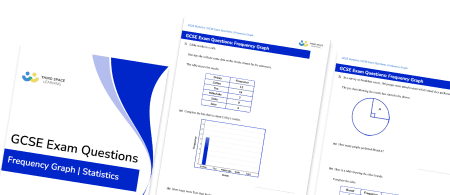FREE DOWNLOAD
Frequency Polygon Worksheet

Help your students prepare for their Maths GCSE with this free frequency polygon worksheet of 18 questions and answers
- Section 1 of the frequency polygon worksheet contains 12 skills-based frequency polygon questions, in 3 groups to support differentiation
- Section 2 contains 3 applied frequency polygon questions with a mix of worded problems and deeper problem solving questions
- Section 3 contains 3 foundation and higher level GCSE exam style frequency polygon questions
- Answers and a mark scheme for all frequency polygon questions are provided
- Questions follow variation theory with plenty of opportunities for students to work independently at their own level
- All questions created by fully qualified expert secondary maths teachers
- Suitable for GCSE maths revision for AQA, OCR and Edexcel exam boards
Unlock access to download your free resource
You can unsubscribe at any time (each email we send will contain an easy way to unsubscribe). To find out more about how we use your data, see our privacy policy.
Frequency polygon at a glance
There are a few different frequency diagrams for grouped data studied at GCSE, these include cumulative frequency graphs, histograms and frequency polygons. In order to construct a frequency polygon we start with a set of data in a grouped frequency table. The midpoints of each class interval are calculated and the data is plotted on a graph with the category groups on the x axis and frequency on the y axis. Data is plotted using the midpoints of the class intervals, and points are joined with straight line segments.
Frequency polygons are particularly useful when comparing two sets of data, for example, the heights of a number of students in different age groups. We can use frequency polygons to identify the modal class interval, it can be found by identifying the highest peak on the frequency polygon as this represents the class that occurs the most.
It is important that students are confident with using inequality notation for class intervals, particularly when working with fractions and decimals.
Looking forward, students can then progress to additional Statistics worksheets, for example a histograms worksheet or frequency table worksheet.

For more teaching and learning support on Statistics our GCSE maths lessons provide step by step support for all GCSE maths concepts.
Do you have GCSE students who need additional support?

There will be students in your class who require individual attention to help them achieve their target GCSE maths grade. In a class of 30, it’s not always easy to provide.
Help your students feel confident with exam-style questions and the strategies they’ll need to answer them correctly with personalised online one to one tutoring from Third Space Learning
Lessons are selected to provide support where each student needs it most, and specially-trained GCSE maths tutors adapt the pitch and pace of each lesson. This ensures a personalised revision programme that raises grades and boosts confidence.








